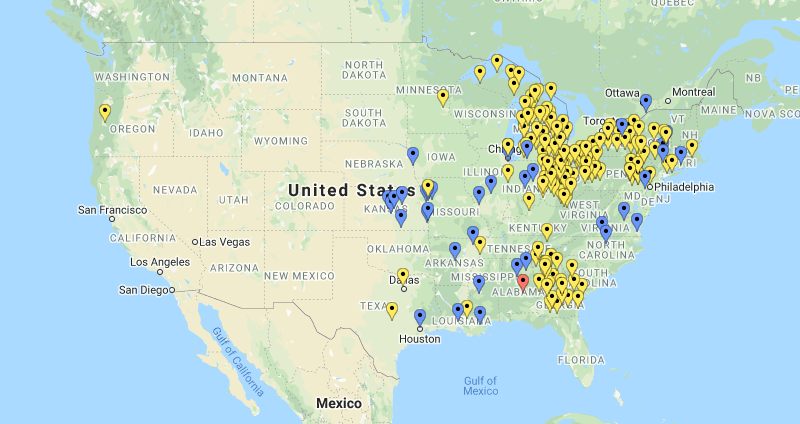Community Progress Shares Support for the “National Land Bank Network Act of 2020” (Press Release)
June 15, 2020

Land Banking Expert Supports Proposed Legislation to Bring $60 Million in Support to U.S. Land Banks
 WASHINGTON, D.C. – June 16, 2020 – Today, the Center for Community Progress (Community Progress), America’s leading resource on issues of vacant, abandoned, and deteriorated (VAD) properties, shared its support for the bi-partisan supported National Land Bank Network Act of 2020, H.R. 7103, introduced by Congressman Dan Kildee, (D-MI-05) and Congressman Drew Ferguson (R-GA-03).
WASHINGTON, D.C. – June 16, 2020 – Today, the Center for Community Progress (Community Progress), America’s leading resource on issues of vacant, abandoned, and deteriorated (VAD) properties, shared its support for the bi-partisan supported National Land Bank Network Act of 2020, H.R. 7103, introduced by Congressman Dan Kildee, (D-MI-05) and Congressman Drew Ferguson (R-GA-03).
“Land banks are a critical tool for rebuilding communities and reimagining vacant spaces. This bill recognizes the importance of the growing land bank movement, its power to advance racial equity, and the national need for federal resources to uplift and connect the diverse field,” said Dr. Akilah Watkins-Butler, President and CEO of Community Progress.
“The urgency of this investment comes at an inflection point, as local leaders around the country confront the future economic impact of COVID-19 on their neighborhoods. We would like to thank Congressmen Kildee and Ferguson for their vision and stand ready to support land banks in their important work.”
Other national organizations that support the National Land Bank Network Act of 2020 include Habitat for Humanity International, LISC, Grounded Solutions Network, Smart Growth America, NAREB, and the National Community Stabilization Trust.
Statewide land bank associations in each of the four states where they exist unanimously support this bill, including the Michigan Association of Land Banks, the Georgia Association of Land Bank Authorities, the Ohio Land Bank Association, and the New York Land Bank Association.
‘We have seen the harm to many urban and rural communities in the aftermath of the foreclosure crisis post 2008. We are still recovering from that trauma,” said Gus Frangos, President of the Ohio Land Bank Association, in a statement supporting the legislation.
“While the work of several hundred land banks throughout the country has achieved tremendous outcomes, challenges remain which require strategy, collaboration, continued creativity, and of course greater funding.”
The Power of Land Banks in the United States
Today, more than 200 land banks across the nation help communities grow racial equity and neighborhood stability by acquiring the titles of problem properties and working with local governments and residents to create neighborhood assets and place them in the hands of responsible owners and residents. These governmental entities, designed to intervene in the cycle of neighborhood decline, have created successes across the country including:
- Land banks in rural and urban communities across New York have attracted more than $120 million in grants and private investment to address thousands of problem properties, returning millions of dollars in land value to the tax roll.
- In Huntington, WV, a community hit hard by the shrinkage of the coal industry, a small municipal land bank demolished 104 properties in 2019 alone as part of a public safety campaign to combat the local opioid crisis.
- Land banks in Ohio, which uniquely benefit from a clever recurring, annual funding mechanism established as part of their state’s 2009 land bank enabling legislation, have innovated some of the most creative housing partnerships in the country, turning tax-foreclosed properties to housing choices for domestic violence victims, refugees, justice-involved individuals, college graduates, and low-income families and individuals.
- Several land banks across Michigan have mobilized and compensated teams of passionate residents to clean and green large inventories of vacant land, and channeled millions of federal dollars to support neighborhood stabilization efforts.
- In Atlanta, GA, the local land bank and community land trust have forged a partnership to direct land bank properties located near public recreational assets to community-ownership and permanent affordable housing.
The article From the Great Recession to COVID-19: Land Banks are Critical to Long-Term Equitable Recovery shares more on how land banks have moved from the fringe to the center of equitable community development.
For more information on land banks and land banking:
- visit the Land Bank Information Headquarters at communityprogress.net/landbanks
- view the National Land Bank Map at communityprogress.net/landbankmap
About the Legislation
The proposed National Land Bank Network Act of 2020 would support creating and expanding a nationwide network that:
- provides resources, education and technical assistance for existing land banks;
- helps communities and local governments evaluate land banking as community development tool; and
- expands America’s knowledgebase on land banking and best practices through research.
The proposed Network would also develop and administer a grant program to support existing and future land banks. The bill provides $60 million in funding over 11 years to establish the network, develop a grant program, and fund grants to land banks and communities building new land banks. To view the full text of the bill, visit H.R. 7103.
For media interviews and more information about the Center for Community Progress, email [email protected] or call (877) 542-4842 ext. 153.
###
About the Center for Community Progress
Since 2010, the Center for Community Progress has helped more than 300 communities transform vacant, abandoned, and deteriorated (VAD) properties into assets for neighbors and neighborhoods. Through offices in Michigan and Washington, D.C., Community Progress works to create a future where all people live in strong, healthy, just communities where widespread vacant properties no longer exist. For more information, visit communityprogress.org.
Recent Press Releases
Subscribe to join 14,000 community development leaders getting the latest resources from top experts on vacant property revitalization.
